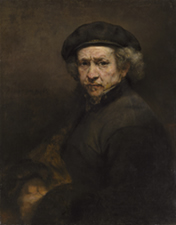The Raleigh Chamber Music Guild’s most recent musical offering featured five shiny brass objects, with not a string in sight. And to fully appreciate the experience, one must expand the concept of “chamber” to include not just a drawing room, but also perhaps a ballroom or even a cathedral sanctuary. Of course, it helps that the music could be tied to the North Carolina Museum of Art’s spectacular exhibit of Rembrandt and near-Rembrandt paintings. And it also helps that the music came with a special explanation from one of the brass players.
Four faculty members from the music program at the University of North Carolina at Pembroke, joined by a music student, presented an all-too-brief “Music in the Time of Rembrandt,” a survey of Renaissance and early Baroque instrumental and choral music transcribed for brass quintet. The performance was quite well done, aided considerably by Joanna Hersey’s explanation of some of the pieces and the history of compositions at this time — the late 1500s through the mid-1600s to some of the music of J.S. Bach in the early 1700s.
Typical instrumentation in a brass quintet calls for two trumpets, a trombone, a French horn and a tuba (sometimes a bass trombone, as the tuba didn’t come into prominence until the late 19th century), and this ensemble contains a richness of sound found almost nowhere else in the musical literature, especially in closing chords. As Ms. Hersey (who plays tuba) explained, the quintet can be considered as two treble voices, two alto voices and a bass voice. And this, for the most part, was how the music was presented at the museum’s auditorium. The players didn’t just hit the notes; they played with great skill, even nuance, with crisp entrances and cutoffs and a well-articulated blend that avoided blarings and “blats.”
The music came from masters of the period: Monteverdi and Gabrieli from Italy and Holborne, Byrd, Morley and Dowland from England, as well as Bach, mainly to show where the Renaissance music was heading in the transition to Baroque styles. The opening fanfare from Monteverdi’s “Orfeo” (sometimes called the toccata), one of the best known brass ensemble pieces, started the concert, followed by William Byrd’s “Alleluia, Alleluia,” which featured prominent trumpets and had a nice tuba line at the bottom of the score. From the secular side, came three pieces by Anthony Holborne and three Elizabethan madrigals by Thomas Morley and John Dowland including the well known “Now Is the Month of Maying.”
In addition to providing the richness of five brass instruments, the pieces also offered opportunities to hear smaller ensembles within the quintet. The opening Holborne piece, “The Fruit of Love,” for example, had a nicely played trio of lower brass consisting of tuba, trombone (Nikki DoBell McCaslin) and horn (Thomas Panepinto). Holborne’s “The Widow’s Myte,” a gentle dance, included a trio of horn, tuba and first trumpet (Timothy Altman). Morley’s “My Bonny Lass” included a nice duet for the trumpets between Altman and Ed Gunther, who is a UNC-P music major. Gunther had several prominent parts, including the lead melody line in Dowland’s “Sweet Love Doth Now Invite.”
The fugal composition of Gabrieli’s Canzona Prima a 5 gave each player several exposed notes as well as a chance to blend with each other, as did the Contrapunctus 1 from Bach’s Art of the Fugue. This Bach piece was perhaps the only one on the program that enabled Panepinto to stand out with a sustained lead line; if there were any shortcoming to the performance it would have been that the golden tone of the French horn was not as prominent as it should have been. Panepinto was seated to the audience’s right, which meant that the bell of the horn faced the back of the stage. (Perhaps in future performances, he and Ms. McCaslin could switch places.)
All in all it was an entertaining afternoon, with a high-caliber performance from five fine musicians. Both the Chamber Music Guild and the Museum are to be commended to bring together art and music in such a fashion.











